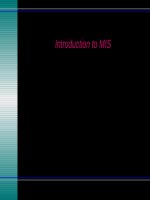Lecture Management information systems: Solving business problems with information technology – Chapter 3
Bạn đang xem bản rút gọn của tài liệu. Xem và tải ngay bản đầy đủ của tài liệu tại đây (2.24 MB, 42 trang )
Introduction to MIS
Chapter 3
Networks and Telecommunications
Copyright © 1998-2002 by Jerry Post
Introduction to MIS
1
Internal
Networks
Teamwork
Communication
Scheduling
Sharing
Internet
External
Suppliers
Customers
Banks
Introduction to MIS
2
Outline
Introduction
Computers
Media
Connection Devices
Software
Shared Media
Switched
Introduction to MIS
Standards
The Internet
How the Internet Works
Internet 2
Mobile Commerce
Global Telecommunications
Network Structure
Sharing Data
Sharing Hardware
Sharing Software
Components of a Network
Technical Problems
Political Complications
Cultural Issues
Comment
Cases: Specialty Retail
Appendix: Creating Web
Pages
3
Sharing Data: Transactions
Internet
Database Management
System and Web Server
Introduction to MIS
4
Sharing Data: Decisions & Searches
Decisions & searches
Teamwork & joint authorship
Team Document
File Server and Database
Data
and
Tools
Report and
Comments
Introduction to MIS
5
Sharing Data: E-mail
Internet
2. Message
transferred to
account on
server.
3. Transferred
via the Internet
to the
destination
account.
1. User creates e-mail message.
Introduction to MIS
4. Message
received when
user checks email.
6
Sharing Data: Calendars
Introduction to MIS
8:00
Mgt meeting
8:30
(open)
9:00
Staff meeting
9:30
Staff meeting
10:00
new meeting
7
Hardware Sharing
Printers
Storage
Processors
tape drive
(backup)
Corporate or
external computer
access
Workstations
Shared
Printer
Server
Files are transferred from workstations to the server.
Software automatically copies files to tapes.
LAN administrator can restore files if needed.
Introduction to MIS
8
Packet-Switched Networks
Data, Voice, Video
All converted to packets
Packet has data, destination, and source address
Switched services
Sent as packets:
Voice
Packets routed as needed
B
2
Reassembled at destination Chicago
12345
New York
C
A
4
1
E
Atlanta
Dallas
5
Computer
Introduction to MIS
D
3
Sent as packets: A B C D E
9
Servers
Work stations
Media
Network Components
Computers
Personal Computer
Cables
Fiber optic
Radio
Infrared
Personal Computer
LAN card
LAN card
Connection devices
Internet
LAN card
Router or Switch
Firewall
Introduction to MIS
LAN card
Server
Shared Printer
10
Server Scalability
Server farms distribute
the workload. Add
more computers for
more power.
Increasing
performance
within a
product family.
Sun 10000
Rack mount
server farm.
Sun 3800
Compaq
Sun Ultra 5
Introduction to MIS
11
Network Transmission Media
Electricity
Fiber optics
Radio waves
Fiber Optic Cable
Example:
Long distance phone lines
reflective cladding
Twisted Pair
Example:
Local phone lines
glass or
plastic
Radio or Micro Waves
Example:
Cellular phones
Coaxial
Example:
Cable TV
antenna
Shield
Introduction to MIS
12
Fiber Optics
Faster
More data
Less magnetic interference
Long stretches without
repeaters
900 copper wires can be
replaced by one fiber
optic line (for telephone
connections).
Introduction to MIS
13
KH
1K
100K
Sound
Radio
Micro
Light
Frequency differences
Amount of data
Distance
Interference / Noise
:
VHF
1M
10M
88
M
54
M
FM
TV
:
HF
UHF
100M
Microwave Optical
1G
10G
Hertz
b
Pu l i c
bl Sa
i f
C c S ety
el
a :
lu fet 15
la
y: 0
Pe Co
r
r
ph 46 M rs
dl
. C es
on 0M 1
60
om s p
es
M
:
. S ho
80 500 Hz
ys n e
0
(P s ( s
M MH
H
C
z z
S) om
PC : 1 e):
.8
9
S
ET 5 G 00
:
- 2 MH
2
z
.
G
H 2G
z
H
z
MF
Pu
LF
All waves behave similarly
-2
-1
55
0K
:
AM
VLF
100
16
65
0
es
in
m
ar
ub
/s
av
y
N
ELF
M
H
-1
08 z
TV
:
M
22
H
z
0M
-5
00
M
H
z
Frequency Spectrum
z
/>
/>Introduction to MIS
14
Transmission Capacity
Introduction to MIS
A thin fiber optic cable can carry as much data as
900 single copper wires, with minimal
interference, and superior tensile strength.
15
The Importance of Bandwidth
Introduction to MIS
16
Shared Connections
With shared connections, machines have to take turns, and congestion
can slow down all connections.
With switched
connections, each
computer has the full
bandwidth of the
connection at all times.
Performance depends on
how fast the switch can
handle connections.
Introduction to MIS
17
Time Division
A
B
A
C
C
A
C
A time
D
Computers A and B split their messages into packets and share
the transmission medium by taking turns sending the data.
Introduction to MIS
18
A
B
frequency
Frequency Division
A
3500 Hz
C
C
D
Computers A and B split the frequency: A uses a higher spectrum.
By listening only to the assigned frequency, multiple transmissions
can occur at the same time.
Introduction to MIS
19
A
B
C
D
frequency
Spread Spectrum
time
Sharing a medium by both frequency and time is one method
of spread spectrum transmission. It is efficient for many computers
because the full bandwidth can be utilized over time and frequency.
Introduction to MIS
20
Wireless
Communication
Microwave transmissions are
used to provide communications
for cellular phones and laptop
computers. As prices of phones,
portable computers, and
communication costs decrease,
increasing numbers of workers
are choosing wireless
technologies.
Introduction to MIS
21
The need for standards
A changing environment
Connecting Networks
Internet
Backbone fiber optic
Routers or Switches
Switch
Hub
Hub
Radio-based network
Introduction to MIS
22
Shared-Media Network
Shared Media
Tap
Introduction to MIS
23
Switched Network
Switch
Servers
Workstations/PCs
Introduction to MIS
24
Enterprise Network
Building 1
Building 2
Fiber optic
Switch
Servers
Firewall
Workstations/PCs
Internet – ISP
Subsidiary
Introduction to MIS
25









